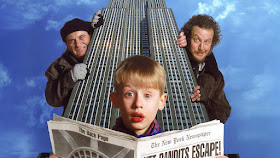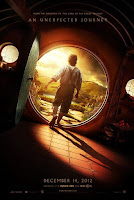 |
| Diana Prince: "They said the age of heroes would never come again." Bruce Wayne: "It has to." |
I really wanted to like it, and not get myself too hyped up about the anticipation surrounding it, particularly from Rotten Tomatoes' score reveal the week of its release. (Okay, I did get a little too worked up about that.) When said score was revealed (around 40 percent at the time), I was like, "Oh, come on. How can they say that?" Then I thought, "Well, at least it can't be as depressing or 'rotten' as BvS was." After I saw JL opening weekend, I did enjoy myself, especially the central characters and the three-year-old in me going gaga over composer Danny Elfman's homage to the original Batman theme from 1989. But a while after seeing the movie, and immediately reading other things online about what it could have been (considering Snyder was replaced by Joss Whedon in post-production with reshoots and various changes made to the middling theatrical version of the film), I was feeling depressed again.
Then, in light of said depression, something strange and ironic happened. I felt an appreciation for BvS a little more, especially for what Snyder and company were trying to artistically express, no matter how bleak or challenging. So, I decided to go buy the "Ultimate Edition" on Bluray (released last year, too) and view it the same weekend. And I have to say, for all its flaws and polarizing elements (this is not a film for children or less discerning viewers), this 30-minute-longer edition is superior to the theatrical cut. Not only does it fill in some of the convoluted plot holes of the latter version. It also spends more time with some of the characters and gives the story a deeper understanding, as well as gravitas. And yes, it is a bit more violent (hence, this version's R-rating).
 |
| (l-r) Ben Affleck (Batman), Gal Gadot (Wonder Woman), and Henry Cavill (Superman) in Batman v Superman: Dawn of Justice (2016) |
The questioning of what heroes (regular and/or super) can do, as opposed to what they should do (or what others believe they should do) is central to this story. "Does he act by our will, or by his own" asks a skeptical senator. Are they needed? Are people worth saving? And how do we define "good"? Furthermore, following Superman's appearance on earth (from another planet, obviously), there are theories and concerns about other "meta-humans" like him. (Clips of those characters do appear later on, from the Flash to Cyborg to Aquaman and of course Wonder Woman, though many would call this more of a collection of "teaser trailers" for upcoming DC films.) Such actions include using elements of power to weaponize, such as the Kryptonian technology, first found by Lex Luthor's company and later stolen by Wayne, each with their own personal agendas. (In Batman terms, Kryptonite represents "fear" and weakness for Kent, obviously.) These theme of characters who take matters into their own hands can be summarized by Wayne: "The world only makes sense when you force it to."
The motif of those who think they're above the law applies not just to various characters' views of Superman, but also about Batman, and even Lex Luthor (Jesse Eisenberg), a warped interpretation who challenges his own view of "God" throughout, maybe on par (or more than) Salieri in Amadeus, regarding the Devil, Heaven and Hell, and a father's influence as well. It's implied that he and several adversaries even arranged for Superman to show up in certain circumstances just to frame him and to expose him as a "false god". As Luthor claims, it's "the problem of evil in the world . . . The problem of you [Superman] above everything else in the world." A blasphemer indeed.
 |
| Henry Cavill |
Both characters, at one point or another, succumb to the belief that "no one stays good in this [hopeless] world." Even so, as Bruce tells us, "There was a time when things were perfect" (my emphasis). A time before darkness, before chaos, before a young Wayne watched his parents murdered in front of his eyes. Yes, we know Batman's origin story countless times over. What Snyder does with this element in the film's opening sequence, however, is poetically foreshadow not only Batman's story, but also the other events that will shape the cities of Gotham, Metropolis, and others around and in between. And it's Thomas Wayne's last word ("Martha") that signifies the end of innocence for young Bruce.
Yes, the infamous "Martha" moment at the climax of the titular fight (which has great buildup and epic scale, to be sure) is easy to scoff at, considering both Wayne and Kent's (earth) mothers share the same name, and many would see this as a lazy and ridiculous way to get both characters to join together. But as I rewatched the film, I realized that when Bruce hears Superman say the name, it powerfully and emotionally forces him to strongly consider the hope and beauty he's about to let be killed--in this case, again ("You're letting him kill Martha!"). This summons the guilt Bruce had over his parents' deaths, as well as the brokenness and lack of humanity he has recently formed in himself.
 |
| Ben Affleck |
The second half of the film is where several standout action sequences occur, including a truck chase, the aforementioned warehouse (a knock out as well as a showcase for the Dark Knight), the titular fight, and Wonder Woman's first appearance in battling Doomsday; when the trio is finally all together, it's a home-hitter and true roller-coaster adrenaline. Plus, the fact that Diana Prince/Wonder Woman (Gal Gadot) serves as a peacemaker between both fallen heroes adds to the theme of characters finding true goodness to fight for again. And Snyder certainly pulls out all the stops with the accelerating action, complete with a rousing score by Hans Zimmer and Junkie XL. (Zimmer has since retired from composing superhero films.)
The tone of this extended version mirrors DC's dark and gritty T.V. shows like Gotham and Arrow. Additional scenes include the brief appearance of Jimmy Olson, Lois Lane (Amy Adams) getting help from a fellow reporter/analyst, and Clark Kent investigating local news of the Gotham City "Bat" ("There's a new kind of terror [besides aliens from the sky]," says one witness, "He is angry and he is hunting.")
 |
| Ben Affleck and Gal Gadot |
Come Together--For Real
Justice League was filmed during 2016, with post-production continuing into this year. The project had had a tumultuous production for years, dating back to 2007 when George Miller was attached to his own project but never fell through. Then, after Snyder's general box-office success of Man of Steel and BvS (not to mention Marvel's ongoing film universe), a JL film was green-lit with returning stars Affleck (Batman), Cavill (Superman) and Gadot (Wonder Woman), as well as newcomers Ezra Miller (The Flash), Jason Mamoa (Aquaman), and Ray Fisher (Cyborg). But Snyder left the project in May this year for family purposes (his daughter had committed suicide back in February), and fellow director and Marvel-veteran Whedon was brought in for reshoots and new material.
The story takes place after the death of Superman, and the impending emergence of a greater threat known as Steppenwolf, complete with flying "Parademon" creatures. Bruce Wayne's faith in humanity, including saving others, is meanwhile being restored. And with the help of Diana Prince, he sets out to gather other "warriors" (meta-humans) in this ultimate battle.
 |
| (l-r) Ben Affleck (Batman), Gal Gadot (Wonder Woman), Ray Fisher (Cyborg), Ezra Miller (The Flash), and Jason Mamoa (Aquaman) in Justice League |
Plus, the stakes don't feel as high or intense as they should be a la the same level that Wonder Woman was on so brilliantly. Footage that includes the backstories of Barry Allen, Arthur Curry, and Victor Stone (Fisher is incredible), and more about other heroes like the gods and the Lanterns, as well as the "Mother Boxes," could of been needed, while keeping the appearance of Steppenwolf (a weak villain overall) at bay until the end--or, at least, to focus on the Parademons and a different adversary for this film. Lastly, Superman's return (no spoiler, really) could've waited until later. (Read writer Paul Asey's thoughts here.)
In fact, many DC fans signed an online petition for a "Zack Snyder Cut" of the film, with the director's original footage as well as original composer Junkie XL's score (Whedon brought in Elfman a week after the former took over). If this turns out to be true (and I hope it is), then count me in. (Check out this original trailer with footage and implied backstory to prove the point.) I mean, hey, if they can do the same with a "Richard Donner Cut" of Superman II (1981), a "Final Cut" of Blade Runner (1982), and of course an "Ultimate Edition" of BvS, they certainly could do it with this film.
 |
| Zack Snyder (right) on the set of Justice League, with Ben Affleck (left) and Gal Gadot (center) |
A word of advice for DC's cinematic universes. Be sure to stick to the same tone and qualities that make your stories successful while letting each film stand on its own. Using Wonder Woman as a prime example, take these three things into account: 1) be gritty without being polarizing, 2) have thorough character investment, and 3) be humorous as long as its in the right places and for the right reasons.











































